Taste and flavor characteristics of Brazilian Sheraton coffee by hand brewing method record of baking of Brazilian Hilado coffee beans
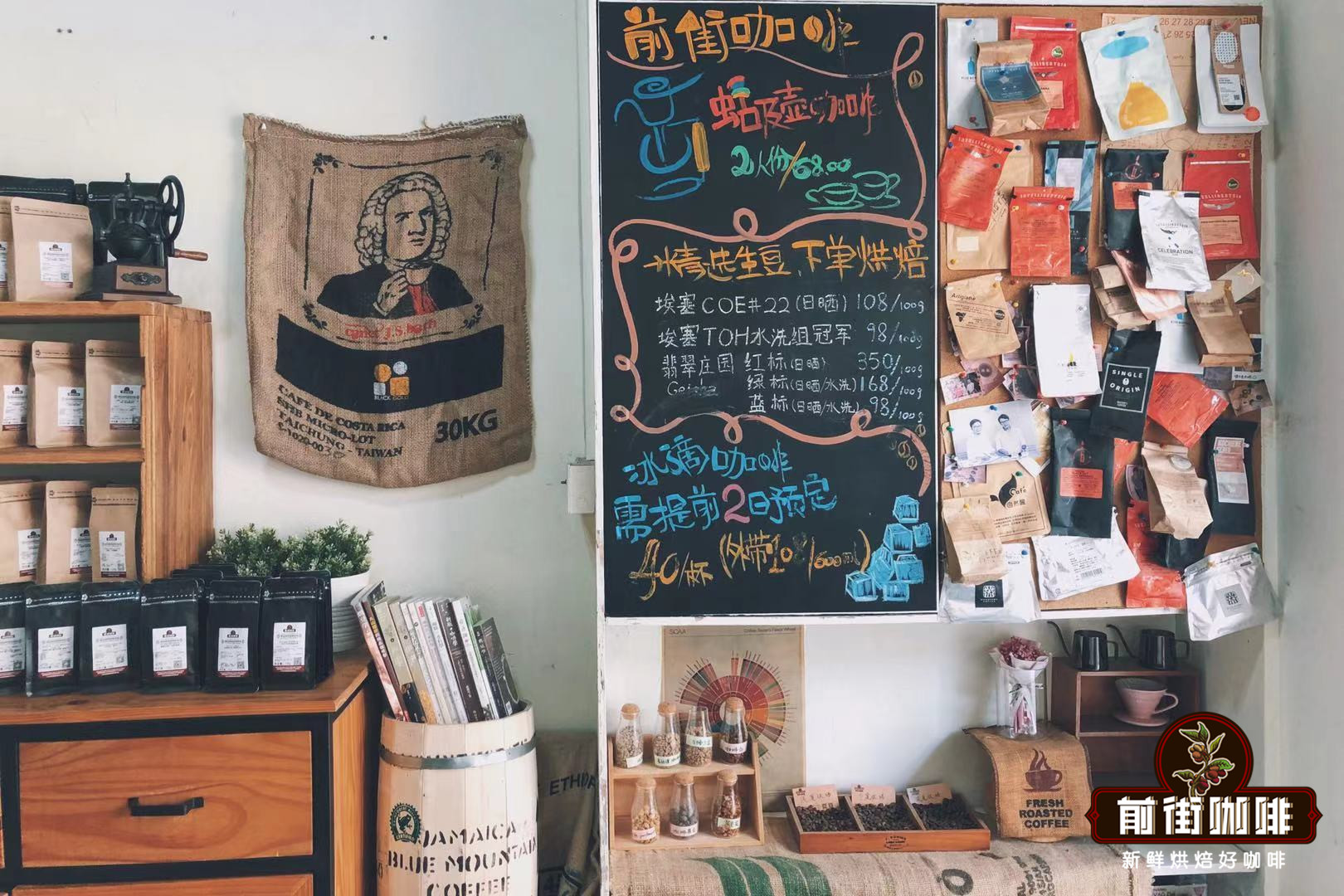
Professional coffee knowledge exchange more coffee bean information please follow the coffee workshop (Wechat official account cafe_style)
Brazil has the largest coffee production in the world, and as long as the country's coffee production is affected, it will directly affect the fluctuation of global coffee. Brazil is the world's largest coffee producer, including Hilado beans from the central and western part of Minas province. In the Qianjie coffee rations bean series, there is a red bourbon from Brazil, which has a distinct flavor of chocolate nuts, mellow and moderate, and is the best choice for friends who do not like sour coffee. Generally speaking, there are two types of guests who come to Qianjie for coffee, those who like sour taste and mellow taste, and Qianjie coffee has corresponding representative coffee beans to recommend. For those who like mellow taste and don't know much about coffee, Qianjie Coffee will recommend this Brazilian Hillado red bourbon because its flavor is classic enough to be recognized even by those who don't drink coffee very much.
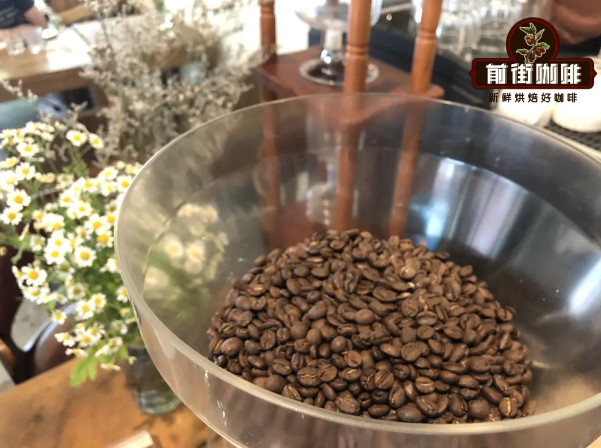
Brazil is located in the Latin American region of the Western Hemisphere, located in the eastern part of South America and on the west coast of the Atlantic Ocean, bordering all countries on the South American continent except Ecuador and Chile; most of its territory lies between the equator and the Tropic of Cancer. It is the most tropical country in the world. The territory has a tropical rain forest climate and a tropical prairie climate. The superior tropical natural conditions are very suitable for the growth and production of tropical cash crop coffee.
Brazil makes full use of the tropical geographical environment and attaches importance to the production and sale of coffee, so that the output, export volume and per capita consumption of coffee have been ranked first in the world for many years, and have been known as the "kingdom of coffee".
Brazilian coffee flavor-supple and sweet
Compared with other countries in Central and South America, the producing area of Brazilian coffee is obviously lower in altitude, flat in landform, lack of microclimate, and no shade for planting coffee trees. Therefore, Brazilian coffee has a unique "soft bean" flavor-low acidity, nutty, sweet chocolate, balanced acid and bitterness, good mellowness, usually with some wood and soil flavor, which is quite different from the obvious floral and orange flavor of African beans.
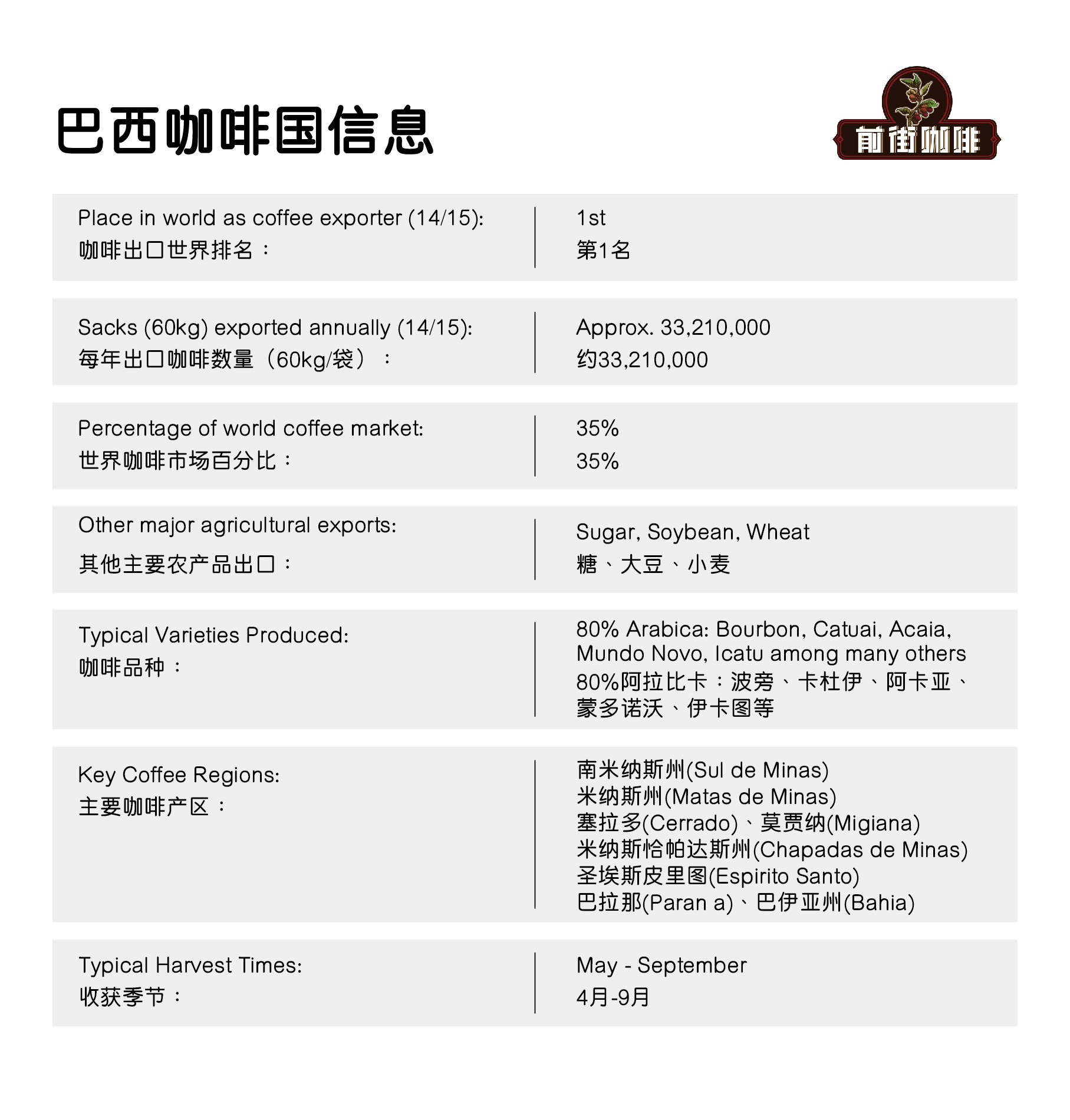
Five Taste classifications for aroma judgment of Brazilian Coffee
Brazilian coffee focuses on the mellow thickness and sweetness of soft beans, which is mild and smooth as a whole, so it uses five grades to distinguish different soft beans! Among them, the order is: extremely supple, slightly supple, not palatable, iodine choking taste.
And these five grades can distinguish between different Brazilian coffee producing areas:
Extremely meek (Strictly Soft): South Minas, Hirado, Mojiana, Bashiya turquoise plateau.
Supple (Soft): Bashiya, Minas southeast mountain forest, Parana, west-central S ã o Paulo, the hills of Espiritusando.
Slightly meek (Softtish): East and northeast of Minas.
Not easy (Hardish): Parana low Haida, Espiri Tusando.
Iodine choking (Rioy): Espiritusando flat, lower southeast of Minas.
Although Brazilian coffee feels monotonous, there are also many fine beans in Brazil recently, among which South Minas, Hirado, Mojiana and Bashiya Diamond Plateau have the most potential!
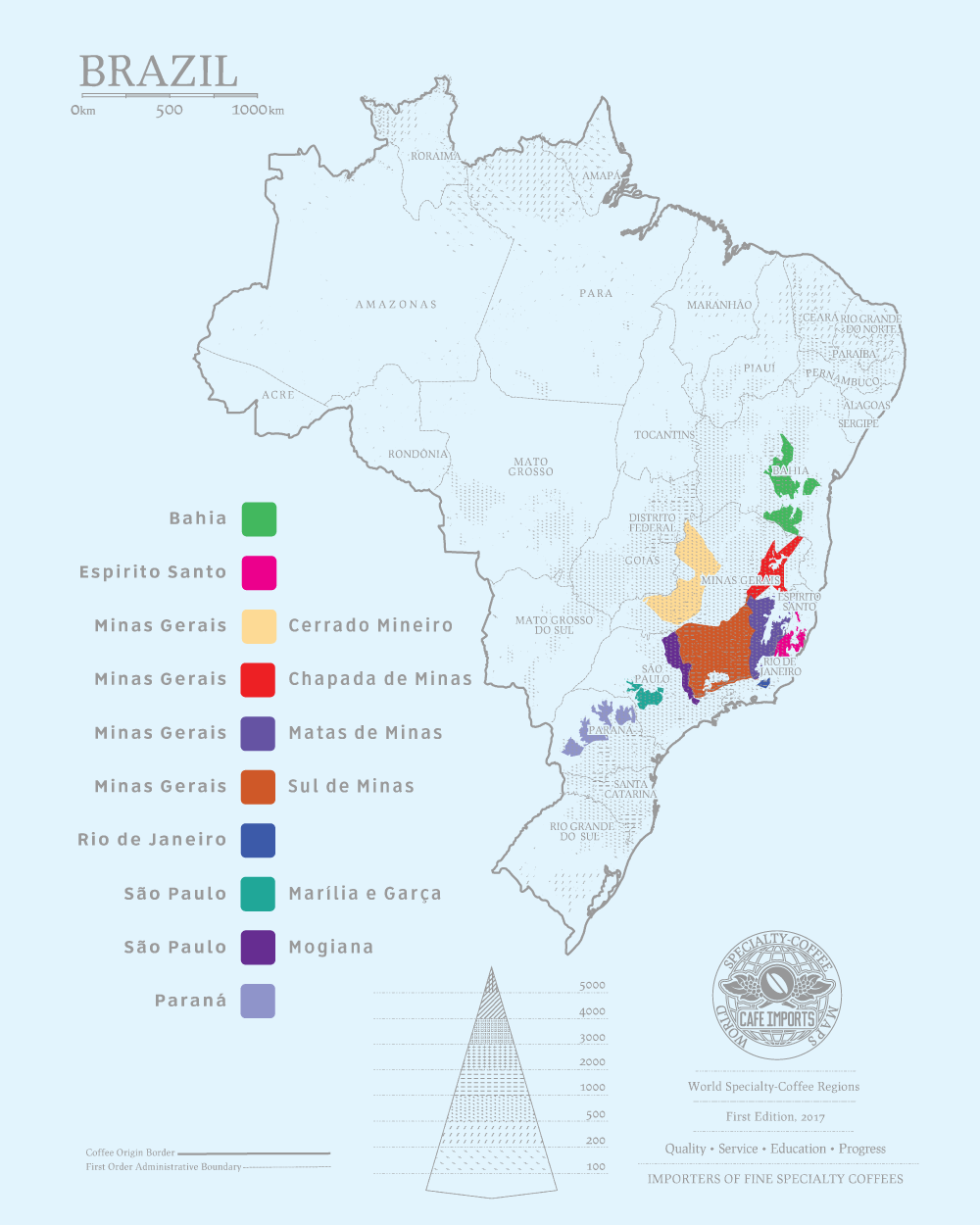
Coffee bean producing area in Brazil
State of Sao Paulo (Mogiana, Centro-Oeste)
State of Parana (Norte Pionerio do Paran á)
Bahia State (Planaltoda Bahia, Cerrado da Bahia, Atlantico Baiano)
Espiritu Santo (Montanhas do Esp í rito Santo, Conilon Capixaba)
Minas Gerais State (Sul de Minas, Cerrado Mineiro, Chapada de Minas, Matas de Minas)
Rond ô nia
Rio de Janeiro State (Rio de Janeiro)
State of Sao Paulo
Morgiana / Mogiana
This area is very close to the south of Minas. Coffee is grown between shrubs, grasslands and other vegetation. There are many farming families in this area, some of which operate in the traditional way of large farms, while others operate in a small-scale and modern way. Modern technology mixed with mountain coffee cultivation culture has created the highest quality Brazilian coffee beans.
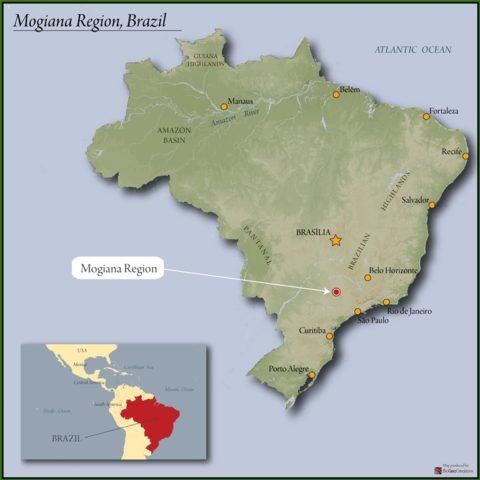
Centro-Oeste / Midwest
(Gar ç a Marilia and Piraju)
Brazilian coffee beans are generally grown in this area by combining large estates with traditional production lines. Although production seems to be declining, it is more pursuing the production of higher quality raw beans.
Paran â Parana
Norte Pionerio do Paran á
The state, which used to be Brazil's largest production region, now has its own unique production technology.
After discovering a decline in the unit yield of coffee woodland, producers in Parana created a new "closed planting system". At present, a large number of coffee trees, seedlings per hectare can better withstand the cold wind, but also ensure a more regular yield.
Bahia, Bahia State
Bahia / Atlantico Baiano: Robusta beans are mainly produced on large farms.
Shapada / Planaltoda Bahia: this area is located in the central state of Bahia and mainly produces hand-screened Arabica coffee. It mainly adopts the method of washing.
Bahia Hilado / Cerrado da Bahia: this area is located in the western state of Bahia and is generally considered to be the latest coffee growing area in Brazil. Modern technologies for irrigation and harvesting are widely used in this area.
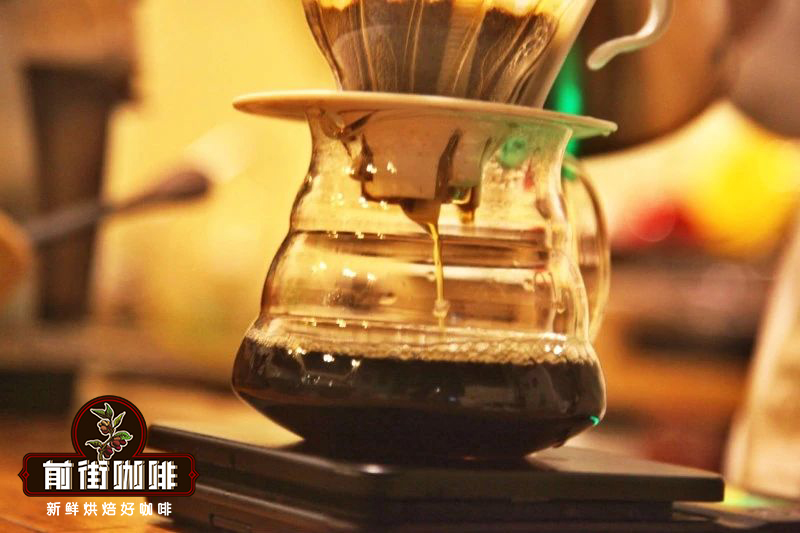
Espirito Santo, Espírito Santo
Montanhas do Espírito Santo
Conilon Capixaba
The state is divided into two main regions, the north, where both large and small plantations grow Robusta beans, and the south, where typical mountain coffee is grown, generally in smaller quantities. This area has both washing and sun exposure.
Minas Gerais
Minas del Sur/ Sul de Minas
The small plantation area produces about 8 - 10 million bags of Brazilian coffee beans grown along the mountains. Suitable altitude, undulating terrain and favourable climate for coffee cultivation, with concentrated rainfall in the months when fruit is needed and dry weather in the months when harvest is needed.
Cerrado Mineiro
Of Brazil's 27,000 square kilometers of coffee bean cultivation, the most famous is the Girado region in Parana, southern Brazil. Unlike other Brazilian regions, which are known for their quantity, the coffee beans of the Cilado region are known for their quality.
Cerrado is actually a savannah covering 22% of Brazil's total area, and is located in the southern plateau of Brazil's "Cerrado Prairie Climate Zone" with abundant native plant species and animals. Cerrado's Portugal meaning means "closed place." The Hirado Prairie begins in Mato Grosso, in the southwest of Brazil, passes through the west-central part of Minas, and reaches the west of Bahia in the north. The coffee producing area referred to by Front Street Coffee is not the whole Xilado grassland, but only the coffee growing area above 1000 meters above sea level in the central and western part of Minas Province, which can be called Xilado coffee producing area. This area is the essence of Xilada grassland, with distinct dry and wet seasons and cooler climate on the plateau, and the ripening time of coffee fruit tends to be consistent.
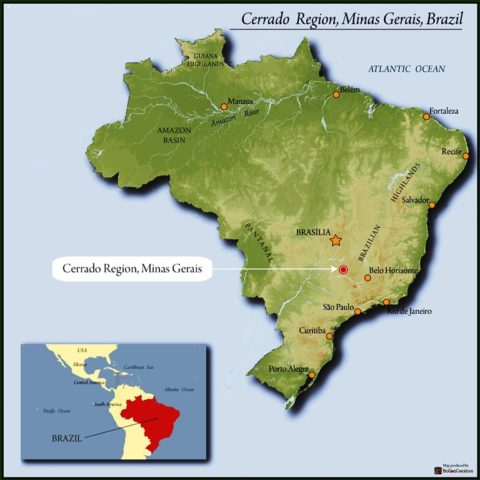
The Hilado producing area is about 1000 meters above sea level, and the annual average temperature is about 21 degrees. The most important thing is that the local soil is very fertile and rich in minerals, so that the coffee beans are well nourished. High altitude, fertile soil, to grow sweet, mellow thickness and high cleanliness of high-quality coffee beans.
Syracuse is a famous high-quality coffee producing area in Brazil, which is handled in a fine way. Unlike Brazilian Santos coffee, Syrador coffee beans are mostly washed or semi-washed. Premium Syrador coffee with nutty aromas, similar to Brazilian Santos but more delicate and clean. The nose is moderate and smooth on the palate, with a slightly sweet finish, charming and sweet, with special aromas of tropical fruits and nutty almonds. The palate has aromas of tropical fruit and nutty almonds, with Xuanmi tea flavor in the finish, with different levels of almond sweetness, milk and tea aromas at low temperatures.
Qianjie Coffee in front Street Coffee in front Street
Country: Brazil
Producing area: Syrador
Altitude: 1000 m
Variety: red bourbon
Treatment: half-sun
Flavor: nuts, chocolate, cream, peanuts, caramel
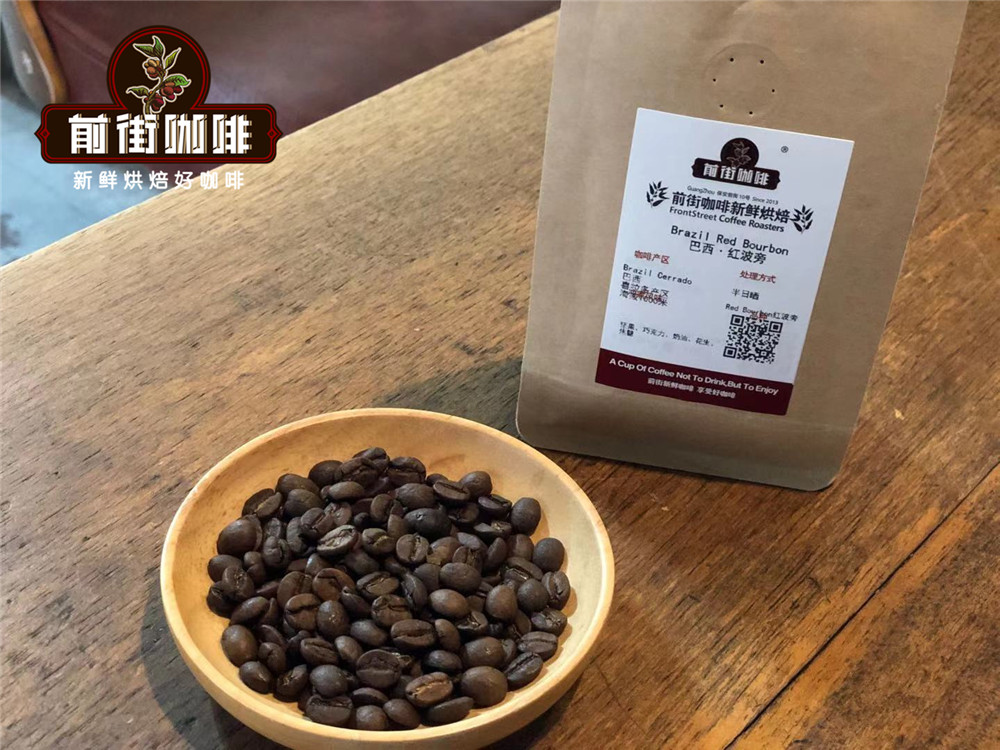
Baking suggestion
Brazilian coffee beans are mainly mellow, and Qianjie coffee is roasted moderately in order to highlight this flavor.
Machine: Yang family 800N, raw bean 550g
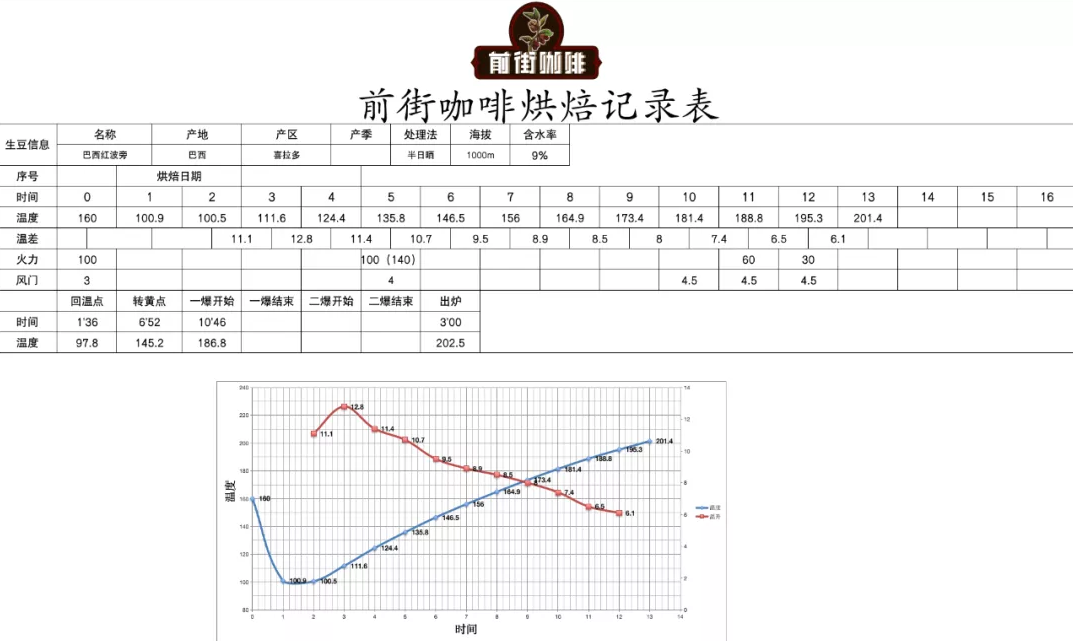
The temperature of soy beans is 160 ℃.
Turn yellowing point 6 / 3 / 39 / 52 ", 145.2 ℃
A burst point of 10: 39: 46 ", 186.8 ℃
The development after the first explosion is 3300 ", 202.5 ℃ comes out."
How to brew Shirado coffee beans in front of the street coffee?
Cooking parameters
Filter cup: Kono filter cup
Water temperature: 88 ℃
Card powder: 15g
Powder / water ratio: 1:15
Degree of grinding: medium and fine grinding (Chinese standard No. 20 screen pass rate 70-75%)
Deep-roasted coffee beans to highlight the mellow feeling of coffee, Qianjie will choose Kono filter cup to brew. The characteristic of Kono filter cup is that it has the function of soaking, which can be used to extract more coffee substances and enhance the mellow taste. Because of its few ribs and located at the low end, the filter paper can be attached to the filter cup to achieve the effect of limiting air flow, so as to slow down the flow speed and increase the contact time of gouache.
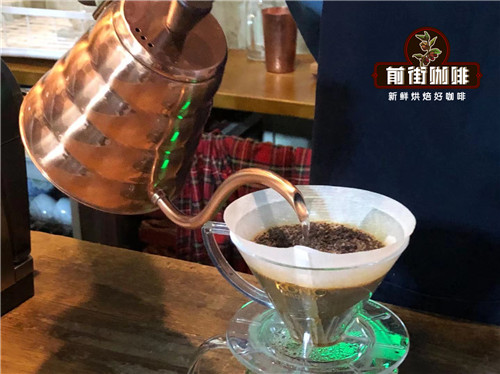
The water temperature is 88 ℃, which can be regarded as a lower cooking temperature, which can avoid excessive extraction of miscellaneous flavor of coffee beans in the cooking process, because the deeper the roasting degree of coffee beans is, the more miscellaneous smell will increase.
Qianjie coffee is extracted by stages, 30 grams of water is steamed for 30 seconds, small water is injected around the circle to 125 grams, when the water level is about to be exposed to the powder bed, continue to inject water to 225 grams to stop, (steaming starts) extraction time is 2 minutes.
Syrador Coffee Flavor description: the entrance has obvious sweetness, with a hint of lemon aroma, with a strong nutty flavor, the latter part has an obvious dark chocolate flavor, the overall feeling is more round.
Minas Shapada / Chapada de Minas
In the northern part of Minas Gerais, the area is very small, but the quality of raw beans is among the best in the world.
Mount Minas Gerais / Matas de Minas
It is a very large area with a very diverse ecosystem and is the oldest coffee growing area in Brazil, and its highest altitude is the best area for coffee processing.
Rond ô nia, Londonia
This area mainly produces robusta coffee.
Rio de Janeiro, State of Rio de Janeiro
Mainly grow Arabica species. Compared with other producing areas, it has excellent port traffic advantages.
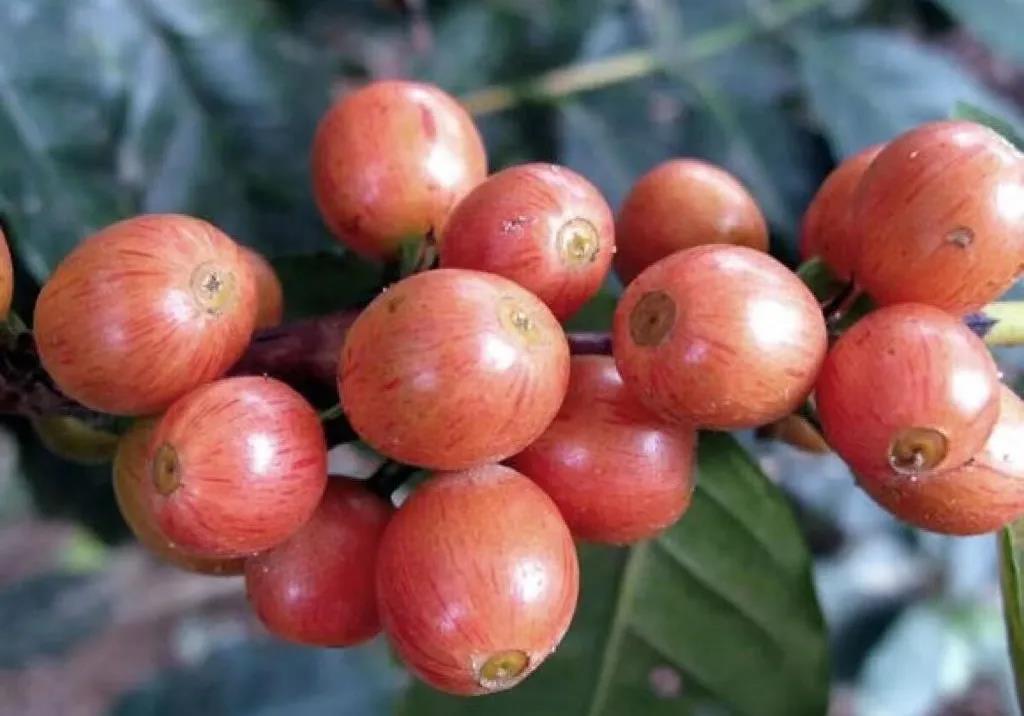
Brazilian coffee treatment
The four most common treatment methods are natural solarization, desizing, semi-washing and water washing, among which natural solarization is the most popular. Natural solarization is very popular in Brazil's two main producing areas, Serrado Minero (Cerrado Mineiro) and Mogiana Paulista (Mogiana Paulista), because the harvest season is the dry season of the year.
Natural solarization
Natural solarization is very different from the water washing used in other Central American countries and Colombia, and since the word "Unwashed" does not fully summarize the essence of this process, Brazilians eventually chose the same term "Natural" as Ethiopian coffee. However, it should be noted that there is a difference between the natural sun method in Brazil and the traditional Ethiopian sun method. What Brazilians call "natural sun" refers to the process of picking coffee rather than the traditional treatment process, because Brazilians allow coffee to fully absorb sunlight on the branches and fully mature.
In Brazil, people put the freshly picked fruit on the terrace to dry, and the dried fruit is called "Boia" (English "ball", that is, "ball"). As I said before, all coffee is picked unpicked, so many of the coffee fruits are overripe during the drying process and dry like raisins. In more modern plantations, workers screen the coffee before drying and peel off the immature fruit by putting all the fruit in a water tank, which floats on the surface of the water because of its lighter weight. Workers can use siphon devices to remove the floating fruit. But in relatively backward plantations, workers do not have enough cash equipment to completely peel off immature fruit, which is why many Brazilian sun-cured coffee are mixed with so many immature beans.
Traditionally, sun-treated coffee usually tastes of leather, tobacco and wood, but the Brazilian natural sun gives the coffee a sweet taste and a balanced fruit aroma. Dr. Flavio Flavio Borem, from the Federal University of Lavelas (UFLA), has conducted in-depth research on the natural sun treatment of raw coffee beans. According to his theory, when using the natural sun method to treat raw coffee beans, in order to ensure the high quality of coffee, people must strictly control the metabolic rate of coffee beans in the drying process to maximize the sweetness, taste complexity and mellow thickness of coffee. Only by strictly controlling the external temperature in the drying process and the speed of fruit drying, can people ensure the integrity of coffee cell structure. In the process of drying, the cell wall of coffee cells is easily damaged. Once the cell structure is destroyed, the quality of coffee can not be guaranteed.
Desizing method
Next, let's talk about desizing. The desizing method was introduced to Brazil 25 years ago by Pinhalense, a well-known machinery and equipment manufacturing company. Desizing is the second most popular way to treat raw coffee beans in Brazil, and Brazilians like to call it "CerejaDescascado" ("Descascado" means "peel" and "Cereja" means "fruit"). In Central American countries, the desizing method is also known as "honey treatment". When using this method to deal with raw beans, the desizing machine is essential, and the coffee treated by this method is extremely sweet and unique in flavor. The desizing machine separates the peel and pulp of the coffee fruit from the raw beans. After completing the desizing step, people will rinse the mucous membrane on the surface of raw beans with water to the desired level before drying. What is unique about this method is that raw beans do not have to be fermented. As there is still a small amount of mucous membrane attached to the surface of raw beans, the drying process of raw beans must be fast to prevent coffee from spoiling and mildew. Once dried, raw beans are placed in a wooden box called "Tulhas" for a period of time to make the taste and aroma of the coffee more constant.
Semi-washing method
Semi-washing is now an outdated method of raw bean treatment in Brazil, which is easy to be confused with desizing, but in my opinion, semi-washing still has some uniqueness. The coffee treated by semi-washing method has a very mellow taste and high sweetness. this method requires the grower's operation technique and experience very high. if something goes wrong, the coffee will become difficult to swallow. Like the desizing method, people first use a desizing machine to desize the fruit, but the difference is that the semi-washing method requires the removal of as much mucous membrane as possible from the peel, pulp and surface layer of raw beans. In Central America, people wash the fruit directly with a washing machine after the fruit is desized, so this method is also known as "mechanical washing". The processed raw coffee beans are very clean and can begin to dry without fermentation. Semi-washed coffee dries quickly at constant temperature, so it tastes purer, less moldy and fruity than other slow-drying coffees.
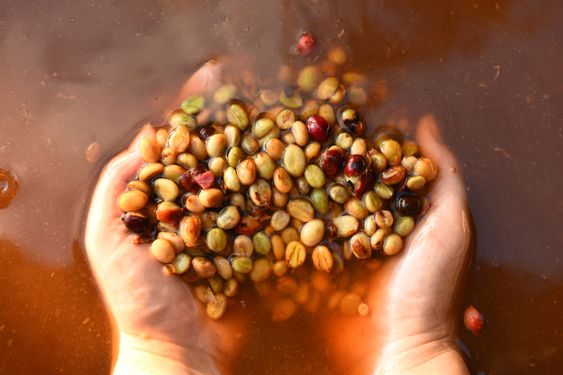
Washing method
Finally, let's talk about washing. Although many Brazilian coffee growers have recently expressed a strong interest in washing, the demand for this kind of coffee is still not high in domestic and foreign markets. The reason is that washed Brazilian coffee has a poor reputation in the international market, and washing technology in Brazil started relatively late, not yet mature. The treatment of washed coffee is very similar to that of semi-washed coffee, but it needs to be fermented to remove mucus from the surface of raw beans. Washed coffee usually has a pure taste and pleasant acidity.
These are the four most common methods of raw bean treatment in Brazil. Once the treatment is completed, only parchment is left on the outside of the raw bean, and the coffee will be finally screened to meet the quality coffee standard. Coffee beans with parchment are sent to a unified drying plant, where coffee is finally sorted, bagged and ready for export. Factory workers will first use vibration screening to grade coffee according to the density of raw beans. You know, density is one of the important criteria to measure the quality of coffee. The graded coffee beans will be cleaned again, and the cleaned coffee beans will be sent to the laboratory for final color grading. The chromometer uses a laser to detect defects or stains on the surface of coffee beans. Generally speaking, in Brazil, the level of mechanization of raw bean sorting is very high. Machining can not only avoid unnecessary mistakes, but also help solve the problem of labor shortage caused by high wages.
For more boutique coffee beans, please add private Qianjie coffee on Wechat. WeChat account: kaixinguoguo0925
Important Notice :
前街咖啡 FrontStreet Coffee has moved to new addredd:
FrontStreet Coffee Address: 315,Donghua East Road,GuangZhou
Tel:020 38364473
- Prev
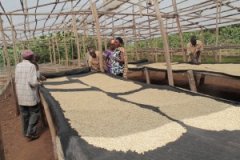
Antigua, Guatemala-how to cook alpine volcanic beans can reflect its unique flavor
For professional baristas, please pay attention to the coffee workshop (Wechat official account cafe_style) Guatemala Antigua-Alpine volcanic beans Guatemala has the best coffee growing environment, including the altitude where the coffee grows and the fertile soil and the cloudy climate of the valley. Waiting for the conditions to match perfectly. The coffee produced in Antigua is the most praised, and it is mentioned that its first impression is the unique smell of tobacco.
- Next
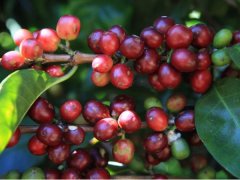
Brazilian Syrador Coffee Bean Cup Test Flavor Taste is Brazilian Hilado hanging ear Coffee good
The exchange of professional baristas please follow the coffee workshop (Wechat official account cafe_style) Brazilian coffee beans are generally divided into five categories. Strictly Soft is very soft Soft is a little soft Softish is a little soft Hardish is not palatable Rioy iodine choking taste this Brazilian-Hirado coffee bean was tested by the local coffee association as Strictly Soft Fine Cup (very soft)
Related
- Detailed explanation of Jadeite planting Land in Panamanian Jadeite Manor introduction to the grading system of Jadeite competitive bidding, Red bid, Green bid and Rose Summer
- Story of Coffee planting in Brenka region of Costa Rica Stonehenge Manor anaerobic heavy honey treatment of flavor mouth
- What's on the barrel of Blue Mountain Coffee beans?
- Can American coffee also pull flowers? How to use hot American style to pull out a good-looking pattern?
- Can you make a cold extract with coffee beans? What is the right proportion for cold-extracted coffee formula?
- Indonesian PWN Gold Mandrine Coffee Origin Features Flavor How to Chong? Mandolin coffee is American.
- A brief introduction to the flavor characteristics of Brazilian yellow bourbon coffee beans
- What is the effect of different water quality on the flavor of cold-extracted coffee? What kind of water is best for brewing coffee?
- Why do you think of Rose Summer whenever you mention Panamanian coffee?
- Introduction to the characteristics of authentic blue mountain coffee bean producing areas? What is the CIB Coffee Authority in Jamaica?

